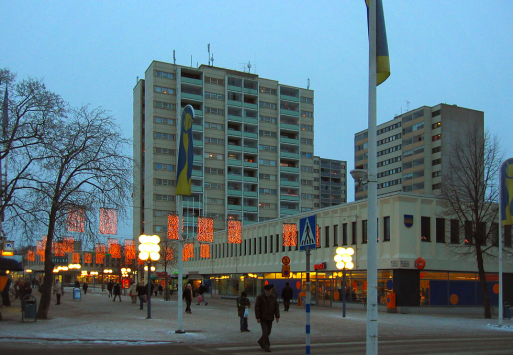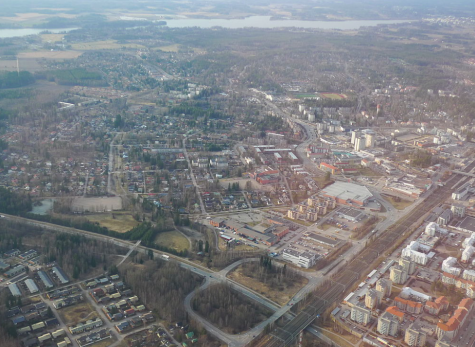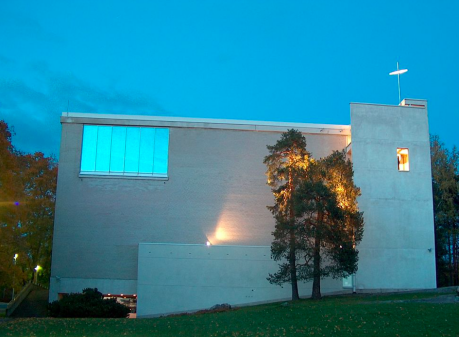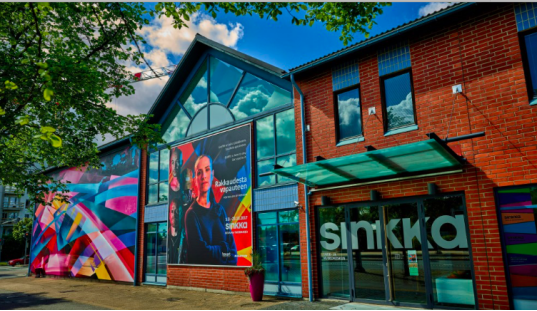Kerava 作者: 来源: 发布时间:2021-10-15
一、所属省或是州,具体位置,人口,面积
Kerava is a town and municipality in Finland. It is located in the province of Southern Finland and is part of the Uusimaa region. Its neighboring municipalities are Vantaa, Sipoo and Tuusula.
The town has a population of 36,292 (31 January 2019) and covers an area of 30.79 square kilometres (11.89 sq mi) of which 0.17 km2(0.066 sq mi) is water. The population density is 1,185.24 inhabitants per square kilometre (3,069.8/sq mi). Kerava is the 30th largest municipality in terms of population, but the 5th smallest municipality in terms of area in Finland (and the second smallest in the Uusimaa region after Kauniainen). The municipality is unilingually Finnish.

二、自然地理
1.地理条件
Kerava is located in the province of Uusimaa, north of the Helsinki Metropolitan Area, 27 kilometers north of Helsinki. Kerava belongs to the frame municipalities of the Helsinki metropolitan area. The main line and the Helsinki – Lahti railway, Lahdentie and the Keravanjoki, a tributary of the Vantaanjoki river, pass through the city. The border neighbors are Vantaa in the south, Tuusula in the west and Sipoo in the east. Kerava forms an almost cohesive urban area that can be roughly divided into the city center and Savio in the south and Ahjo in the east. The center of Kerava is surrounded by several radial streets, and the pedestrian street, called the longest in Finland (850 m), runs under the center (Pori is also mentioned as the oldest and longest pedestrian street in Finland). Kerava Prison is located on the outskirts of Kerava.
At the end of 2017, Kerava had 35,554 inhabitants, of which 34,886 lived in agglomerations, 62 in sparsely populated areas and the coordinates of the place of residence of 606 inhabitants were unknown. The degree of agglomeration is calculated for those residents whose coordinates of residence are known; The degree of agglomeration in Kerava is 99.8%. The Kerava city center no longer forms a separate agglomeration, but the entire population of the Kerava agglomeration (34,886 people) belongs to the Helsinki city center. In addition to Kerava, Helsinki's city center extends to several Helsinki neighborhoods.
2.交通情况
Transport connections in Kerava are varied. The city is happy to profile itself as a model city for light traffic, from which it has received recognition. The city has extensive cycle paths, which are plowed in winter like motorways. There are comprehensive bike racks and residents are encouraged to come to the train by bike. The pedestrian street in the densely built-up center is forbidden for cars and along it is the main part of the city's service offerings. The city center also has a tightly regulated parking policy to reduce motoring.

The pedestrian street complex received the Environmental Structure of the Year award in 1996. Its design began as early as 1962 in an architectural competition that created the idea to surround the city center on a ring road. Construction began in the early 1980s, when the easternmost part of Tuusulantie, which led from the center of Kerava to the church village of Tuusula, was rendered car-free after traffic and maintenance changes, and traffic was diverted to bypasses. At the same time, the pedestrian section was named Kauppakaari. The promenade was later extended under the railway to its east. This extension was completed in 1995, but the promenade is still under development.
There are two railway stations, Kerava and Savio, which are served by commuter trains in the Helsinki metropolitan area. The Kerava city line, which was completed in autumn 2004, and the fourth track introduced with it, offer even more frequent train services to Helsinki. From Kerava, the railway also leads to Porvoo, but the railway has not been used for regular passenger traffic since 1981; only on summer Saturdays old-style passenger trains (Dm7) operate between Kerava and Porvoo. However, the railway leading to the Kilpilahti Neste oil refinery, which has daily freight traffic, diverges from the Porvoo line; instead, the section of track leading from the fork to Porvoo has been converted into a museum track. In addition, passenger traffic to Sikkoo's Nikkilä is currently planned for a period of 20 years, at which point the train would stop at least in Ahjo.
Kerava railway station is an interchange (transfer) station, with connections from the main track from Helsinki to Riihimäki to the tracks to Lahti and Sköldvik/Porvoo. Helsinki Airport is located about 12 km to the southwest of the city. The underpass of Sampola runs under the main line, connecting the areas east of the center and the track.
Kerava is about 15 kilometers from Helsinki-Vantaa Airport. There are several bus lines to Kerava from Helsinki and a connection line from Koivukylä station. In addition, buses run to Hyrylä, Sipoo, Nikkilä and Söderkulla and to Porvoo's Kilpilahti. The city of Kerava has made a significant contribution to the construction of the city line and is committed to ensuring that the majority of public transport is handled by train. This has meant that the position of the bus is weak and direct connections to Helsinki have been reduced. There are also not many internal bus connections. The bike is often a faster means of transport than a bus when going to a train station. Intra-city lines 5, 8 and 9 serve the weakened bus traffic after the construction of the city line.
In March 2006, Kerava joined the HSL area, which means that Kerava has a common travel card for the Helsinki metropolitan area. With the same ticket, you can travel by train and bus both in Kerava and elsewhere in the Helsinki metropolitan area (but not in other Central Uusimaa municipalities). There is also no longer a need to make a decision between the train and bus monthly card, as both can be used to travel to the Helsinki metropolitan area. Since joining the HSL area, traffic supply has been improved. In 2008, the Central Uusimaa regional ticket was introduced as a new option, with a monthly card it is possible to travel unlimited from other parts of Central Uusimaa to Kerava. However, the ticket will not be sold to Kerava residents because the city does not support ticket cooperation with Matkahuolto. However, with the Central Uusimaa regional ticket, residents of other municipalities are able to travel to Kerava on lines 933, 950 and 953 outside HSL. Along the roads, Kerava can be reached either from Lahdenväylä on the east side or Tuusulanväylä on the west side. The Lahti motorway and the Old Lahdentie run through Kerava from the east of the city center.
三、经济发展和规模
Opening of Kerava Central Park on October 17, 2006. Kerava has 12 primary schools, one high school, two vocational schools and Laurea University of Applied Sciences. The associations also run the School of Fine Arts, the Music College and the Dance College. The city has an indoor swimming pool, an indoor swimming pool and an ice rink, as well as a prison. The Central Uusimaa Rescue Department and Savio VPK operate in Kerava. The city has a health center; the nearest hospital is Peijas Hospital in Vantaa. There is a Kerava emergency center in Kerava, which is responsible for emergency calls throughout Uusimaa. The renewed Kerava City Library was opened on September 1, 2003. Kerava belongs to the Uusimaa constituency and has 51 city councilors in its city council. Mayor Petri Härkönen resigned unexpectedly on April 11, 2016.
Statistical information regarding Kerava is compiled annually for its own statistical publications, Taskutilasto (Eng. Pocket Statistics) and Tilastokirja (Eng. Statistical Yearbook). The publications present statistical information on, for example, the population, labour force, housing, finances and services. As its name suggests, Taskutilasto (Eng. Pocket Statistics) contains the latest information as a small, compact package. Tilastokirja (Eng. Statistical Yearbook) presents the information in more detail and over a longer period of time in the form of a printed report, which can be obtained from the financial services of the central administration. A large part of the statistical information can also be obtained from the public statistical services. On the other hand, the most detailed information on the town's economy can be found in the annual report.
GPS coordinates of Kerava: N 60.401033, E 25.107644
Annual balance 26,1 € millions
Annual balance 734 €/inhabitant
Operating expenditure 194,1 € millions
Tax revenue 155 € millions
Income tax percentage 19,25 %
Loans 37,9 € millions
Loans 1 067 €/inhabitant
Financial result 14,5 € millions
35 531 inhabitants
According to the Ministry of Finance, economic growth will still look positive in the near future, despite weak news from the international economy. Domestic demand will sustain economic growth in the coming years. Growth in private investment and consumption will slow as the uncertain external environment is reflected in the expectations of Finnish companies and consumers. The importance of public consumption and investment for GDP growth will be emphasized especially next year.
General government expenditure has remained higher than revenue throughout the economic downturn. There is a structural deficit in the general government, which is projected to increase in the coming years. Public finances are weakened by slowing economic growth, expenditure growth due to an aging population and expenditure increases in line with the government program.
In 2019, Finland's GDP will grow by 1.5%. Export growth is sluggish as the European economic outlook remains uncertain. Residential investment is declining, but growth in productive investment is also slowing as the international economy weakens. Private consumption will continue to grow, supported by rising earnings levels and high employment.
GDP will grow by 1.0% in 2020 and 0.9% in 2021. Growth in private consumption will slow as household savings increase. The share of investment in GDP is declining. Trade tensions between key economies are reflected in world trade and indirectly affect Finnish exports.
The slowdown in economic growth and the rise in nominal wages are gradually beginning to dampen employment growth. The employment rate will rise to 73.4% by 2021 as the working age population continues to decline. The unemployment rate will slowly fall to 6.2 per cent in 2021.
https://www.kerava.fi/kerava-info/in-english/financial-and-statistical-information
https://www.kerava.fi/kerava-info/yleistietoa/tilastotietoa
https://www.kerava.fi/Documents/Talousarvio%202020%20ja%20talousarviosuunnitelma%202020-2022.pdf
四、产业特点/重点项目
Kerava is a major industrial city. The main industrial areas are located near the track to its east. The city manufactures food, textiles, metal products and furniture, among other things. In addition, there is a diverse small industry. Kerava's largest employers after the city are Sinebrychoff, Tuko Logistics, Metos, Uusimaa Hospital Laundry, Kokkikartano, Ifolor and Kerava Prison (founded in 1927). There is one shopping center in Kerava, the Karuselli Shopping Center.
Rocking Rock is a natural, beautiful and very diverse place to spend your leisure time. In winter, you can go skiing and sledding on the rocking cliff. There is a frisbee golf course and a wooden treadmill in the area, which are freely accessible to city dwellers during the summer. At the top of the swing there are sports equipment designed for the open air. The Kerava City Council decided in the 2013 Celebration Council that Keinukallio be developed into a significant sports and leisure center for the whole of Finland.
Kerava products rose to prominence in 2005 as a result of the launch of the Kerava cap. In 2012 Kerava-green fuzzy dice were launched, and they raced all the way to the finals of the municipality marketing competition. Kerava fuzzy dice has been sold in thousands, even beyond the borders of Kerava and Finland.
The newest Kerava product is the Kerava lamp, which was launched in October 2013. The Kerava lamp was born as a collaborative project between the Town of Kerava, the heirs of Yki Nummi and Innojok Oy. It was inspired by the Kupoli table lamp designed by Yki Nummi, which was tailored into a Kerava-looking lamp with small details. The lamp represents the unassuming and proportionally beautiful production of Nummi. Nummi worked as a lamp designer in the Stockmann-Orno factory of Kerava from 1950 to 1975. A variable selection of Kerava products are for sale at the information desk of the Town Hall at Kauppakaari 11. Products are paid for in cash.
https://www.kerava.fi/kerava-info/in-english/kerava-products
五、风景名胜,景点( attractions)
1. Kerava Church

Kerava Church is a church located in Kerava, designed by architect Ahti Korhonen and completed in 1963. There are about 500 seats in the church. The church serves as the main church of the Kerava parish.
The church building of Kerava Church is asymmetrical in floor plan, the altar is on the longest wall and the concrete bell tower and sacristy at one corner of the church. Oak has been used as a counterweight to the concrete. The church covers an area of 900 square meters. The altar has a metal relief designed by Kauko Räsänen, acquired by 1977, the power of God, in addition to which the church has a stained glass crown by Lauri Ahlgrén. The church's 25-voice organ was manufactured by the Kangasala organ factory, originally in 1963.
The church was renovated in 1993, when the organ and interior were also renovated. For the 40th anniversary of the church, textile artist Maisa Kaarna designed a rug called Lupaus, which is above the pulpit. The interior also includes a mission candle designed by the church's architect Ahti Korhonen.
2.Art and Museum Centre Sinkka

Art and Museum Centre Sinkka, which opened in 2012, is home to the Kerava Museum and the Kerava Art Museum. Sinkka showcases works from the designers of the Keravan Puusepäntehdas cabinetmakers factory and the lamp and light-fixture factory Orno interlaced with contemporary art and the latest trends in visual arts. In addition to the exhibitions and events Sinkka’s guests can enjoy the Museum Shop and Café or book private events from small-scale meetings to large functions.
Kerava is located about 30 kilometers from Helsinki city center. You can access Kerava by local trains R, Z, K, T and D (from Helsinki), by R (from Tampere), by Z (from Lahti). Sinkka is about 600 meters from the Kerava Train station. All rooms open to public are accessible with assistance for persons with disabilities. There is a free car park behind the building. The café and museum shop follow the same opening hours as the museum.
http://www.sinkka.fi/summary-in-english/
3. Cycling map of Kerava
The cycling map made collaboratively by Kerava, Järvenpää and Tuusula has now been published. The map gives an overall view of the light traffic routes of the municipalities. The area consists of several kilometres of bike paths in the densely built town and urban environment as well as in the countryside. In addition to bicycle routes, points of interest for bikers, culture-lovers and outdoorsmen are marked.
The map scale is 1:35,000, and it represents the situation as of 2006. One side of the map depicts the cycling routes of the area. The reverse side consists of a partial magnification of the centre of Kerava and highlights the most important traffic rules and instructions for cyclists.
The cycling map is distributed in the three municipalities, and is available in e.g. the town and municipal hall, libraries and sports places. The map can also be found as several PDF files on the internet at: www.kerava.fi/pyorailykartta.asp. The map is broken down into smaller pieces in order to ease the printing onto A4 sheets."
https://www.kerava.fi/kerava-info/in-english/tourism/getting-around
六、历史文化
1.历史
The Kerava area is known to have been inhabited since about 7,000 BC, when it was still on the shores of ancient Lake Ancylus. These inhabitants of the area made their living from hunting, and they moved a lot throughout the year. Eight Stone Age settlements are known from Kerava, the most significant of which is Lapilan Pisinmäki. Stone objects, fireplaces, bone fragments and pottery have been found in the area, dating back to two stages of settlement. The earliest of these is from the period of Suomusjärvi culture around 6500–4200 BC. and later from the period of young ceramic culture around 2500-2000 BC.
Until the Middle Ages, Kerava was a wilderness, until two villages, Ylikerava and Alikerava, were created along the Keravanjoki River. The first signs of established village settlement date back to the 1440s. In the middle of the 16th century, the population of the area was about 160. At that time, Kerava belonged to the Sipoo administrative district. Kerava was annexed to Tuusula when the Tuusula parish was founded in 1643. In 1862, the railway between Helsinki and Hämeenlinna was opened, which quickly brought industry to agricultural Kerava. Among other things, brick factories and a cement, tile and rocket factory were established there. Around the railway station, the agglomeration developed into a city for the future city. The carpentry factory in Kerava was established in 1908, and the wood industry became an important factor in the development of the city. The coat of arms designed by Ahti Hammar features a joint made by a carpenter, galvanized. In 1924, Kerava was separated from Tuusula as its own shop. At that time, it had a population of about 3,000. Initially, it also included part of the Korso area, and Korso railway station was also located in the township area. However, from 1954 onwards, the entire Korso was annexed to the then Helsinki countryside.
The reason for founding the shop was that the railway connection and station established in 1862 had led to an increase in the population of the municipality of Tuusula and began to demand that the municipality build municipal technology in the station village. However, the decision-makers of the municipality of Tuusula were not ready for these investments, which is why they started demanding their own independent municipality. On June 15, 1923, the first government of Kyösti Kallio passed a government decree, according to which the Kerava township was ordered to be established at the beginning of the following year. Kerava Day is celebrated annually on June 15 or the closest Sunday. Regionally, the Kerava township was established in the villages of Ali-Kerava and Yli-Kerava. The settlement was originally concentrated in Lapilanmäki, Helleborginmäki or Auringomäki. The construction of an underpass tunnel from the eastern side of the railway stabilized the development of the center of Kerava. The area of Kauppala was 39.2 km² in 1924–1953, but from 1954 onwards it was only 30.79 km², when Korso and Nikinmäki were annexed to the rural countryside of Helsinki, now the city of Vantaa. In the first municipal elections in Kerava, in December 1924, 24 councilors were elected.
In the 1940s and 1960s, detached houses and low-rise buildings were built in the Sompio district, as well as detached houses in Kaleva to meet the needs of the growing population. During the peak periods of the late 1960s and 1970s, the population almost doubled due to emigration and good transport connections, and new suburbs were created in Kurkela, Kilta and Untola. Kerava received city rights in 1970. In the 1980s, the detached house areas of Ilmarinen and Pihkaniity were built and more apartment buildings were built in the city center. Kerava is still a growing city in the wake of the metropolitan area. Its population growth during 2003 was 1.5 percent. Currently, new construction is being planned or carried out in Kurkela, Kytömaa and Virrenkulma detached house areas, Ahjo, Sompio and Myllylaakso, among others. Large-scale new construction is also planned in the city center.
2. 文化体育
Kerava is known e.g. its circus market, garlic festivals and Kerava products, in particular hair follicles. Many garlic dishes were named Kerava's parishes in the 1980s: lamb like George (à la Jorgos), garlic potatoes and crushed garlic in oil, and a dessert gooseberry pie with vanilla sauce.
Many athletes who have advanced to the top of the world come from Kerava, such as swimmer Joona Puhakka, footballer Jukka Raitala and swimmer Hanna-Maria Seppälä. The most successful athlete in Kerava is Volmari Iso-Hollo, who gained fame at the Olympics in the 1930s.
Kerava has e.g. two ice rinks, an indoor swimming pool, an indoor swimming pool, an athletics field and two artificial grass fields (Kaleva and Ahjo). The indoor swimming pool will undergo a complete renovation during 2017-2018. Talma Ski Slope and Adventure Park is located near the eastern border of Kerava on the Sipoo side.
七、其他信息
The centre of Kerava is densely built-up and cars are prohibited from entering the pedestrian streets. The Central European style pedestrian street of Kauppakaari was created in the early 1980s. Today it is nearly one kilometre long. This vicinity is the centre of trade and business. Festivals and markets are also arranged there. The Finnish Association of Architects has awarded the pedestrian street in its entirety with the SAFA award.
The park plantations in Kerava have also amassed praise and been awarded with the national Vihervuosi award. Kerava also invests in maintaining light traffic flow. Pedestrians' and cyclists' needs are ensured by our 70 kilometre long light traffic network. The active light traffic development of Kerava has even been acknowledged in the form of the Tienviitta award; issued by the Finnish Association for Transport Planning.
https://www.kerava.fi/kerava-info/in-english
八、联系方式
Town manager: Kirsi Rontu
Phone: 0127485-5
Email: kerava@kerava.fi
Address: Kauppakaari 11 PO Box 12304201 Kerava
https://www.kerava.fi/yhteystiedot/kaupungin-osoitteet
